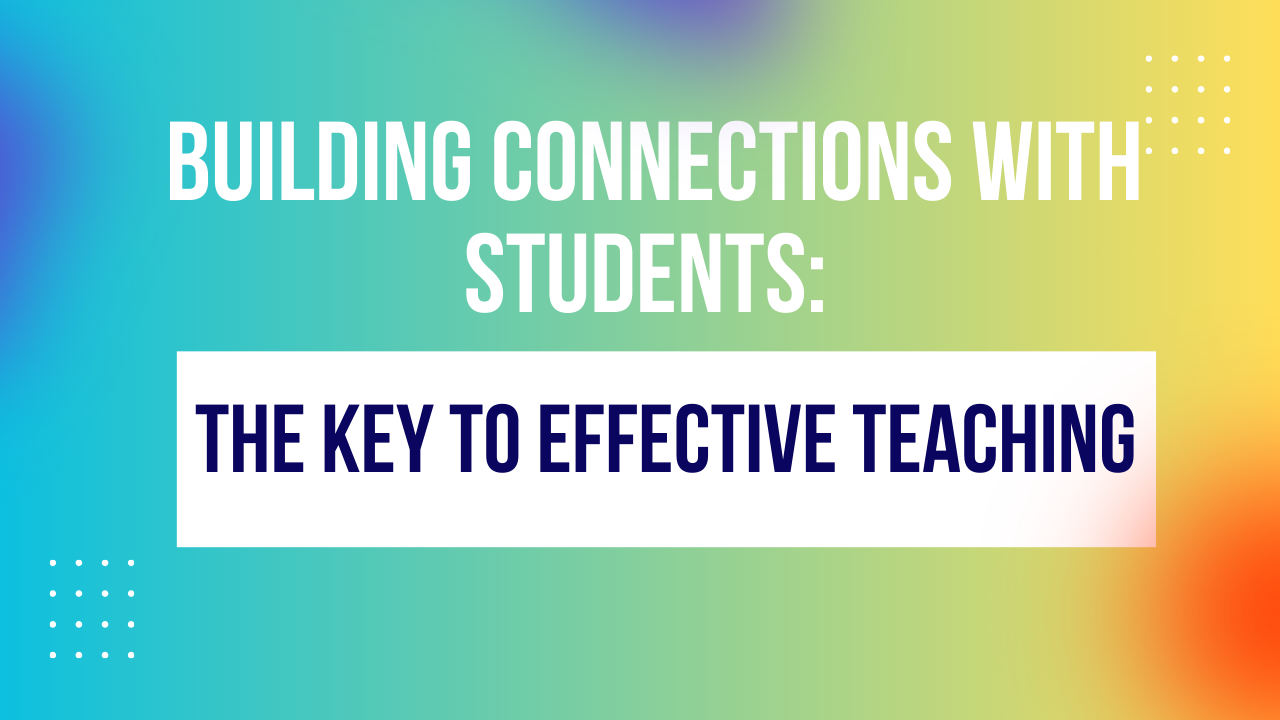Building Connections with Students: The Key to Effective Teaching
At the heart of every effective teaching experience lies a strong, meaningful connection between educators and their students. Building these relationships goes beyond lesson plans and academic goals—it’s about understanding students as individuals, fostering trust, and creating a supportive environment where learning thrives. When teachers invest in connecting with their students, they not only boost engagement but also inspire confidence, motivation, and a lifelong love of learning. Whether through active listening, personalized support, or simply showing genuine care, these connections are the foundation of transformative education.
Building Connections with Students: The Key to Effective Teaching
Teaching is more than delivering information or guiding activities—it’s about creating meaningful connections. These connections, particularly in language learning, lay the foundation for trust, motivation, and ultimately, success. When students feel seen, heard, and valued, their engagement skyrockets, and their learning potential soars.
We’ll be explore why building connections with students is crucial, how it enhances language learning, and practical strategies for educators to foster these connections. Whether you’re a seasoned teacher or just starting out, these insights can transform your teaching experience.
Why Building Connections Matters in Language Learning
Let’s start with why building connections is so impactful, especially in the context of language learning.
Learning is Personal
Language isn’t just academic—it’s deeply personal. Students aren’t just learning grammar rules or vocabulary; they’re acquiring a tool to express their identities and connect with the world. When teachers build relationships, they create a safe space where students feel comfortable taking risks and making mistakes.Motivation Thrives on Relationships
A strong teacher-student connection can ignite intrinsic motivation. When students feel that their teacher believes in them and genuinely cares about their success, they’re more likely to stay committed, even when the material gets challenging.Trust Enhances Communication
Language learning involves vulnerability. Students often feel self-conscious about pronunciation, grammar errors, or speaking in front of peers. Trust allows students to lower their defenses and participate fully, accelerating their progress.
The Role of Emotional Intelligence in Teaching
Building connections requires emotional intelligence (EI)—the ability to understand and manage your own emotions and empathize with others. Here’s how emotional intelligence plays into teaching:
Self-Awareness
Recognizing your own emotions helps you stay calm and patient, especially when students struggle or act out.Empathy
Understanding your students’ feelings and challenges allows you to tailor your teaching to their needs. For example, a student who seems withdrawn might just need a little encouragement to open up.Relationship Management
Strong relationships are built on mutual respect and communication. A teacher with high EI can navigate conflicts and foster a positive classroom culture.
Practical Strategies for Building Connections
Let’s dive into actionable strategies to connect with your students, making your teaching more effective and enjoyable.
1. Create a Welcoming Environment
The atmosphere you create sets the tone for the learning experience.
Warm Greetings: Start each class with a smile and a genuine greeting. For example, learn how to say “hello” in your students’ native languages.
Personalized Touches: Use students’ names often and remember small details about their lives—like their hobbies or favorite topics.
Safe Spaces: Encourage open communication by letting students know that it’s okay to make mistakes. In language learning, mistakes are part of the process!
2. Show Genuine Interest in Your Students
Students are more likely to engage if they feel valued.
Ask Questions: Find out why they’re learning the language and what goals they have. Is it for travel, work, or personal growth?
Listen Actively: When students share their thoughts, listen without interrupting. Reflect back on what they’ve said to show you’re paying attention.
Celebrate Wins: Whether it’s mastering a tricky grammar rule or speaking up for the first time, celebrate their progress—big or small.
3. Incorporate Their Interests
Tailor your lessons to include topics your students care about.
Custom Vocabulary Lists: If a student loves cooking, teach them food-related vocabulary. For a student interested in travel, focus on useful phrases for navigating new places.
Themed Lessons: Create lessons around their hobbies, favorite TV shows, or even trending topics in their culture.
Cultural Exchange: Allow students to share elements of their culture. This not only makes learning more engaging but also promotes mutual understanding.
4. Use Humor to Break the Ice
Laughter is a universal language that can dissolve tension and build rapport.
Funny Examples: Use humor in your teaching materials. For example, create silly sentences to illustrate grammar rules.
Laugh at Yourself: Share your own language learning struggles. It humanizes you and shows students that everyone makes mistakes.
5. Adapt to Their Learning Styles
Every student learns differently. By recognizing and catering to individual learning preferences, you show that you’re invested in their success.
Visual Learners: Use images, charts, and videos to explain concepts.
Auditory Learners: Focus on listening exercises, songs, or verbal explanations.
Kinesthetic Learners: Incorporate movement into your lessons, like role-playing or hands-on activities.
6. Be Approachable
Students should feel comfortable coming to you with questions or concerns.
Office Hours or Availability: If possible, set aside time for one-on-one chats or virtual meetings.
Open Body Language: Maintain eye contact, nod to show understanding, and avoid crossing your arms.
Encourage Questions: Regularly invite students to ask for clarification. Phrases like “There are no silly questions” can put them at ease.
7. Build a Collaborative Classroom
Encourage students to work together and support each other.
Group Activities: Pair or group students for discussions, role-plays, or collaborative writing exercises.
Peer Feedback: Let students review each other’s work. It builds camaraderie and reinforces learning.
Language Partners: If you’re teaching a diverse group, pair students with different native languages to practice together.
8. Provide Constructive Feedback
Feedback is crucial, but how you deliver it matters.
Be Specific: Instead of saying “Good job,” point out exactly what they did well, like “Your pronunciation of that word was spot on!”
Balance Positive and Negative: Start with praise, address areas for improvement, and end with encouragement.
Set Clear Next Steps: Give actionable suggestions so students know how to improve.
Overcoming Challenges in Building Connections
Even with the best intentions, building connections isn’t always easy. Here are common challenges and how to address them:
Shy or Reserved Students
Start with low-pressure activities like writing or small group discussions.
Be patient; some students need more time to open up.
Cultural Differences
Learn about your students’ cultural norms and adapt your approach accordingly.
Avoid assumptions and ask questions to understand their perspectives.
Time Constraints
Use quick check-ins or icebreakers to build rapport without taking too much class time.
Incorporate connection-building activities into your lesson plans.
The Long-Term Benefits of Building Connections
When you prioritize building connections, the benefits extend far beyond your classroom.
Increased Retention and Engagement
Connected students are more likely to stay motivated and participate actively.Stronger Communication Skills
When students trust you, they feel more comfortable practicing speaking, leading to faster improvement.Lifelong Learning
A strong teacher-student connection fosters a love for learning, encouraging students to continue their language journey even after your class ends.
Final Thoughts: Your Role as a Language Guide
Teaching a language is more than grammar drills and vocabulary lists—it’s about empowering students to connect with the world. By building strong, meaningful relationships with your students, you create an environment where they feel supported, inspired, and ready to succeed.
What strategies have worked for you when building connections with your students? I’d love to hear your thoughts and experiences in the comments below. Together, we can create a community of educators dedicated to fostering connection and growth.
Happy teaching! 🌟

